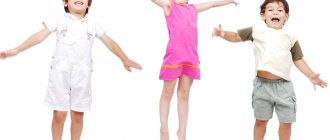Neuroses in childhood and adolescence are quite common. One of their varieties is neurasthenia.
In the first years of life, a child actively explores the world. No matter how much his family protects him, no one manages to avoid conflict, stress and other unpleasant situations. Children, depending on their temperament and personal resistance to stress, react differently to stimuli.
The baby’s nervous system cannot always cope with the tension that comes from stressful situations happening around. Then it fails, and as a result, neurasthenia develops.
Parents see changes occurring in their child, but often do not understand the reason for them. They perceive the first signs of neurological disorders as a repeated accident or a bad habit. However, this disease requires close attention from adults; they are the ones who are able to notice initial changes in behavior and communication and promptly contact a specialist.
What is the essence of the disorder?
Neurasthenia in children is a reaction to external irritating factors, the environment, or any events. It can progress in three directions:
- hypersthenic – increased activity, noisy behavior, emotional arousal. The child loses self-control and shows dissatisfaction for any reason. Constantly changes types of activities, but cannot concentrate on any one activity. Bad mood and irritability predominate;
- hyposthenic – weakness, tearfulness, fearful state. Accompanied by increased fatigue. There is lethargy in movements, a decrease in interest in things that previously caused a surge of emotions;
- transitional - neurasthenia, in which the symptoms and signs of the first two types in children and adolescents appear alternately. There are serious sleep disorders and exhaustion of the nervous system.
In general, this is a psychogenic disorder, the basis of which is a contradiction between the individual and parties significant to him (most likely, close relatives), which is resolved unproductively, unsuccessfully and irrationally. It causes painful, painful experiences. Develops in childhood, during the period of personality formation.
Neurasthenia is a functional, reversible mental disorder in which organic brain damage does not occur.
Painful overstrain of psychophysiological potentials takes the child out of the usual rhythm of life. Unable to meet the high demands of others, he considers himself incapable of overcoming difficulties in advance. There are many reasons for creating such a state, but most often it is relationships with parents.
It is the closest people who unknowingly destroy the child’s inner world. They cannot accept their child for who he is and are strict and demanding. Their children try to meet expectations, but often the demands are too high and do not correspond to their capabilities. Against this background, a disorder develops - neurasthenia.
In children, its symptoms are pronounced, but can be corrected more quickly. For adults, everything is much more complicated. At a conscious age, neurosis of this type can cause much more problems than in childhood.
Without appropriate medical care, adolescents and children develop problems with social adaptation, difficulties in building relationships with peers, and even the development of depression. If the disease is noticed in time and appropriate measures are taken, then the acquired disorders of the nervous system are completely reversible.
Features of neuroses in adolescence
The incidence of neuroses in adolescence is significantly lower than in childhood, and the relatively high incidence of neuroses (about 15% of those registered in psychoneurological dispensaries) is due to those adolescents who have suffered from neuroses since childhood. It may be surprising that the period of puberty, the “pubertal crisis,” does not lead to a sharp increase in the incidence of neuroses. Probably the fact is that at this age there is a tendency to “replace” neurotic vegetative and motor symptoms with behavioral disorders. The same psychogenic factors that cause neurosis in children and adults, although with different patterns of manifestations, lead to deviant behavior in adolescents during the period of character development.
In adolescence, the same forms are distinguished as in adults: neurasthenia, hysterical and obsessive-phobic neuroses. In terms of the picture of neuroses, this age is undoubtedly closer to adulthood than to childhood, when one encounters still poorly differentiated forms.
The difference from adults consists in some features of psychogenic factors and psychogenesis, reflecting the specifics of adolescence (for example, the emancipation reaction), as well as in a more distinct connection of certain forms of neuroses with certain types of character accentuations.
Neurasthenia
Neurasthenia is the most common form of neurosis in adolescents. It develops more often in representatives of asthenoneurotic and labile types of character accentuation. Its main symptoms in adolescents are the same as in adults. Increased fatigue, especially during mental stress and exciting situations, is combined with irritability, which increases with fatigue. Hence, psychological protection becomes the desire to protect oneself from physical and mental stress [Smetannikov P. G., 1981]. Sleep disturbances, headaches, low mood and a tendency to hypochondria are also observed.
Just as in adults, two types of neurasthenia can be distinguished - hypersthenic and asthenohypochondriacal.
Hypersthenic type. The leading symptom is extreme irritability, which intensifies with fatigue and in a tense environment. Outbursts of irritation arise from insignificant reasons and often end in tears and repentance. They can be addressed to both family and friends, as well as completely random strangers, both adults and peers.
Excitability also manifests itself in intolerance to noise, less often bright light and strong odors. Pronounced autonomic lability can be judged by fluctuations in pulse rate, blood pressure, and vasomotor play. Sometimes vegetative reactions reach the level of crises reminiscent of diencephalic ones - with sharp tachycardia, profuse sweat, redness or pallor of the skin, intestinal spasms, dizziness, a feeling of lightheadedness, etc. Usually such attacks follow severe anxiety. In girls they occur more often during menstruation.
Sleep disturbances are manifested by difficulty falling asleep, sometimes restless sleep with heavy dreams and repeated awakenings [Tupitsyn Yu. Ya., 1971]. Headache is usually of the “muscular type” [Karvasarsky B.D., 1980] - with a feeling of tightness, compression, and soreness of the skin on the head. Headaches are worse in the morning, especially if the teenager gets up later than usual, “sleeping off the previous days” (“Sunday morning headaches”). Complaints about difficulty concentrating during classes and worsening memory are also common.
Asthenohypochondriacal type. In these cases, increased fatigue, lethargy, and a tendency to continually seek rest and peace come to the fore. Instead of outbursts of anger, irritability manifests itself in tearfulness and lamentations. Along with complaints of poor sleep, difficulty falling asleep, lack of freshness after sleep, lethargy and drowsiness during the day are emphasized. Complaints about headaches are usually overshadowed by a mass of other somatic complaints - palpitations, irregularities, discomfort in the heart area, pain in the area of the heart impulse, abdominal cramps, dull and unclear pain in different parts of the body. The heart most often remains the center of hypochondriacal experiences during neurasthenia in adolescents, especially in boys. Perhaps the reason for this is growth characteristics - a physiological lag in the increase in the size of the heart from the growth of the whole body. In girls, hypochondriacal complaints about the function of the gastrointestinal tract are no less common. As a rule, a decrease in mood is noted, but unlike endogenous and reactive depressions, the decrease in mood appears little outwardly.
Flow. Neurasthenia usually lasts a long time - months and years with periods of significant improvement until complete practical recovery and new deterioration under the influence of mental trauma and difficult stressful situations. However, in most cases there is no steadily progressive deterioration and therefore there is no need to talk about “neurotic development”. With proper treatment and favorable conditions, even very prolonged disorders can gradually disappear by the end of puberty.
Differential diagnosis. First of all, it is necessary to exclude chronic somatic diseases, often accompanied by a neurosis-like syndrome (chronic cholecystitis, spastic colitis, chronic pneumonia, bronchial asthma, etc.), as well as cerebrovascular disease after traumatic brain injury and as a consequence of brain infections and intoxication. It should be kept in mind that teenagers sometimes hide traumatic brain injuries from their parents. With cerebrovascular disease, headaches are more often of the vascular type (with a feeling of pulsation in the head), combined with dizziness, riding in transport, swings, heat and stuffiness, weather changes with sharp fluctuations in atmospheric pressure are poorly tolerated.
The criteria for differential diagnosis with asthenohypochondriacal syndrome in neurosis-like sluggish schizophrenia are described in more detail in Chap. XV. The absence of obvious psychogenic factors preceding the disease may suggest this, but their presence does not exclude their provocation of low-grade schizophrenia. Subsequently, with the latter, an unusual pretentiousness in the description of hypochondriacal experiences, complaints about difficulties in thinking, and not only about poor memory and the inability to concentrate, as well as isolation from peers and indifference and even hostility towards loved ones gradually emerge. The differences from the hypochondriacal equivalent of depression are not always clear. With depression, external manifestations of decreased mood are more visible and there is no pronounced vegetative lability.
prevention of alcoholism – previous | next – obsessions
Adolescent psychiatry. Content.
Manifestations of the disease
With any type of neurosis, there is no damage to the brain centers, but only a functional disorder. The first signs become noticeable already in early childhood, but only a few parents pay attention to them and take appropriate measures.
The most important sign of increasing neurasthenia is a decrease in performance, as far as it would be appropriate to say about children. If we are talking about schoolchildren, then the teacher must make a lot of effort to attract attention, not to mention any return.
It is common for a child who is a carrier of the disorder to blame himself for all troubles. His self-esteem is low or at zero.
It has been observed that boys are more susceptible to the disease than girls.
Symptoms of neurasthenia in children:
- increased nervous exhaustion;
- absent-mindedness;
- diffidence;
- impaired concentration, attention;
- dissatisfaction, moodiness;
- fussiness;
- excited state;
- attacks of aggression;
- weakness;
- fast fatiguability;
- sleep disturbance.
When transitioning to a chronic form, apathy or depressive symptoms may be present. From the autonomic nervous system, jumps in heart rate and wandering pain in the abdomen or chest are observed. Excessive sweating often occurs. Appetite with neurasthenia is practically absent.
Since the manifestations of neurasthenia in children vary, its symptoms can be mistaken for some other mental disorder.
Causes of neurasthenia
The development of the disease is usually preceded by a traumatic factor.
Mental trauma is a sensory reflection of some event in the child’s mind, which has a depressing effect on him, worries him and lasts for quite a long time. The most common reason for the development of neuroses in childhood and school age is, oddly enough, overly “caring” parents. Their desire to give their child what they did not have, overprotection and constant control overload the child not only physically, but also psychologically.
From birth, children have individual temperament, capabilities and limitations. Not all parents understand this. Wishing only the best for the child, they burden him with additional activities, often without even considering his interests. A student’s day can be scheduled minute by minute: after school – sports training, music or art school, swimming pool, English, tutor, homework, etc.
Afraid of upsetting his parents and realizing that they are trying for his good, the baby tries to do everything: study diligently, attend clubs. However, somewhere inside, fatigue and protest accumulate. This is a classic development of neurasthenia. At some point, the child breaks down, becomes irritable and aggressive, or, conversely, whiny and inhibited.
If there are several children in the family, then problems may begin due to jealousy towards the youngest family member. In teenagers this is more pronounced; it seems to them that their parents no longer love them, they don’t need them, since a “new” baby has appeared.
The situation is especially aggravated when the elder is often told that he is already an adult and has a special responsibility, and he himself missed the moment when he grew up. He is still small at heart and still needs parental love and support. Trying to meet the expectations of adults, the child experiences nervous overstrain, leading to frustration.
Triggers for the development of neurasthenia are also:
- negative family environment - scandals, fights, divorce of parents;
- social and everyday problems;
- mistakes in education;
- parental use of alcohol or drugs;
- emotional psychological trauma;
- severe fear;
- hereditary diseases;
- lack of sleep;
- reduced immunity;
- frequent respiratory tract infections;
- acquired physical injuries;
- digestive system disorders.
Most often there is not one, but several reasons. Due to this, diagnosis and treatment are delayed.
Treatment
The primary examination is carried out by a local pediatrician. If he identifies any deviation, he gives a referral to a child psychologist or psychotherapist. If serious problems are detected, the patient is sent for further examination to a neurologist. In severe cases, hospitalization in the neurological department is required.
A neurologist together with a psychotherapist makes a diagnosis and prescribes treatment. The doctor analyzes the situation in the family, collects a complete history of the disease, and identifies predisposing indicators.
To achieve positive treatment results, an integrated approach is used. First of all, it is necessary to get rid of the traumatic factor, then reduce physical and psychological stress.
Treatment should be aimed at calming the child and, depending on the type of pathology, at slowing down or speeding up certain body functions. It is important to find out the parents’ opinion about the current situation: what they see as the cause of neurotic disorders.
It is recommended that the whole family attend psychotherapy sessions, because mistakes in the educational process cannot be corrected by working only with the child. Correction is carried out using various methods, including:
- Gestalt therapy;
- hypnosis;
- biofeedback therapy;
- group or family sessions;
- play therapy.
The reversibility of the problem largely depends on the immediate environment. Parents should remember that children have their own lives, and it has its own differences and characteristics, for example:
- not every child is destined to become an excellent student
- not everyone has an ear for music or a desire to attend art school;
- If the older child is interested in football, then the younger one is not obliged to do so.
Children cope with neurasthenia much more successfully than adults. This happens because children's perception of the world is not fully formed; they do not have strong convictions. The therapy gives positive results quite quickly. The destructive processes of the functioning of the nervous system stop and continue to develop in the right direction.
Diagnosis and treatment of astheno-neurotic syndrome
Diagnosis of the disease does not require complex procedures. To identify neurasthenia, a survey of a neurologist is sufficient, but it is important that the patient is completely frank and does not hide any details. For an experienced specialist, it is not difficult to determine astheno-neurotic syndrome only from the existing clinical picture in the first stages of its development, not to mention the third. Therefore, treatment is prescribed immediately.
The main difficulty in diagnosis is discovering the cause or complex of factors that provoked the development of the disease. This point is always given paramount importance, since it is by influencing the cause that the existing problem can be completely solved, while symptomatic therapy will give an effect only for a while. But, unfortunately, it is not always possible to immediately identify all factors.
Treatment of astheno-neurotic syndrome is always complex and involves:
- drug therapy;
- psychotherapy;
- lifestyle corrections;
- therapeutic massage or manual therapy;
- physiotherapeutic procedures.
When a disease is detected in a child, it is usually enough to adjust the lifestyle. Eliminating frankly harmful foods and caffeine-containing drinks from the menu and replacing them with freshly squeezed juices, fruits, vegetables, berries, as well as avoiding prolonged viewing of TV, computer games, etc. usually helps bring the child’s condition back to normal. Long walks in the fresh air are very beneficial, especially before bed. At the same time, it is important to establish a daily routine and strictly adhere to it, so that the baby goes to bed at the same time and can fully rest.
Drug therapy and physical therapy
The nature of drug therapy is selected in accordance with the severity of chronic fatigue syndrome. Therefore, if at the 1st stage of its development it is enough to use herbal teas or traditional medicine in combination with taking complex vitamin preparations, then with more serious changes the prescription of a number of sedatives and antidepressants is required.
Thus, drug treatment for chronic fatigue syndrome may include:
- sedatives (sedatives) of plant origin, including tinctures of valerian, motherwort and complex preparations such as Persen - reduce the excitability of the nervous system and help reduce anxiety;
- antidepressants - prescribed when there is no effect from taking sedatives, they quickly relieve anxiety, calm, but can provoke the development of side effects;
- antiasthenic drugs – increase vitality and restore energy;
- nootropics – improve brain function, increase the ability to concentrate, improve memory and the course of thought processes;
- adaptogens, including Eleutherococcus tincture – help increase the body’s ability to adapt to changing living conditions;
- vitamins – have a general strengthening effect on the body.
The effect of the drugs is supplemented by the appointment of physiotherapeutic procedures. Most often, for astheno-neurotic syndrome, it is recommended to undergo a course of reflexology and electrosleep sessions.
Many people enjoy aromatherapy. In the absence of allergies, no one can prohibit the patient from using this treatment method to normalize the psychological state and overcome existing problems. But aromatherapy can only act as an auxiliary method of treatment, and does not replace the therapy regimen prescribed by the doctor.
Psychotherapy
Since personality traits and psychological factors play a large role in the development of astheno-neurotic syndrome, treatment of the disease, especially in the later stages of development, is impossible to imagine without the help of a psychotherapist or psychologist. This specialist will help to identify deep-seated personality problems, traumatic situations and work through them in order to eliminate the pressure they create.
It is almost always recommended that patients find an outlet for themselves - some kind of hobby that will bring pleasure and help them relax. This could be any activity from knitting, drawing, spending time with a pet, collecting coins, or reading.
Particularly effective elements of psychotherapy for patients with astheno-neurotic syndrome are art therapy and sand therapy. Drawing in general helps to cope with tension and throw out any accumulated emotions and experiences, and often it helps to get to the bottom of the problem and find an easy way to solve it.
Breathing exercises are of great benefit for people with chronic fatigue syndrome, as it has a relaxing effect on the body and puts you in a good mood.
Lifestyle correction
Since a person’s lifestyle plays an important role in the development of astheno-neurotic syndrome, much attention is paid to its correction. It is often recommended:
- to refuse from bad habits;
- increase the level of physical activity, cardio exercise and yoga are especially useful;
- avoid overexertion;
- alternate work with rest;
- take vitamins;
- pay attention to nutrition.
The diet for astheno-neurotic syndrome consists of avoiding the use of synthetic energy drinks, as well as minimizing the consumption of coffee, tea, and other caffeine-containing drinks. They are replaced with herbal infusions, hawthorn or rose hip infusion, tea with chamomile, mint, lemon balm, etc. Be sure to enrich the daily diet with fresh fruits and vegetables. At the same time, it is advisable to minimize the amount of fried and fatty foods and baked goods consumed.
Therapeutic massage and manual therapy
Both procedures involve manual pressure on the soft tissues of the back, which provides a pronounced relaxing and healing effect. But manual therapy differs from therapeutic massage in that during the session the specialist also works on the spine. As you know, the quality of functioning of the whole organism and especially the nervous system depends on its condition. Therefore, manual therapy sessions make it possible to influence the main link in the development of chronic fatigue syndrome – autonomic disorders.
Consequently, both therapeutic massage and manual therapy have a positive effect on the patient’s recovery rate. But if for mild forms of the disorder only therapeutic massage is sufficient, then for more serious disorders or the desire to achieve maximum effect, preference should be given to manual therapy.
Thus, almost everyone can encounter a disease such as astheno-neurotic syndrome. In the initial stages of development, it cannot be considered a life-threatening condition, but if the problem is ignored, it can still become a serious disorder. But timely, comprehensive treatment will allow you to completely cope with it and return to a normal, fulfilling life.
4 1 vote
Article rating
What other neuroses are there?
According to world statistics, 15 to 25% of children, mostly males, suffer from various neuroses. Age range - from one and a half years to adulthood.
Neurasthenia is far from the only nervous system disorder that affects people at an early age. There are quite a large number of neuroses, the symptoms and signs of which are similar, but there are also fundamental differences.
Preschool children and adolescents may be susceptible to types of nervous disorders such as:
- fear neurosis - the patient begins to panic fear of darkness, fire, loneliness, death, etc.;
- hysteria - most often manifests itself in childhood in the form of screams, crying, falling to the floor;
- Hypochondria is more common in teenagers. Morbid fear for one’s health, inventing non-existent diseases;
- obsessive movement neurosis - various phobias are accompanied by nervous tics: blinking, shrugging shoulders, licking lips, etc.;
- depressive neurosis – depression, desire for solitude;
- logoneurosis - stuttering, occurs due to muscle spasms of the speech apparatus;
- Enuresis – involuntary urination;
- somnambulism – sleep disorder, sleepwalking, nightmares;
- Anorexia is a neurotic eating disorder.
As already mentioned, unfortunately, not all parents believe that neurasthenia developing in children and adolescents can pose a serious threat to health. Some think that these are temporary age-related difficulties or whims, others do not notice any changes in the child’s behavior at all.
Prevention of childhood neuroses as a factor in preserving the health of preschool children. consultation on the topic
Prevention of childhood neuroses as a factor in preschoolers’ health.
Psychoneurologist A.I. Zakharov gives the formula: “A child who is in a state of stress, overstrain, fatigue, has reduced immunity, and, as a rule, gets sick (somatic diseases, vegetative disorders). Frequent illnesses serve as the starting point for the development of neurosis.” We, preschool teachers, need to know and promptly identify children with a tendency to neuroses, in order to protect and strengthen the health of preschoolers.
Which children are more susceptible to neuroses? 1. Children with increased emotional sensitivity who take everything very close to their hearts; impressionable children prone to anxiety and excitement.
2. Impressive children, prone to internal processing of feelings and experiences. They say about such children: “Keeps everything to themselves.” 3. Children with internal instability:
- with a nervous constitution (the influence of genetics: neurosomatically weakened parents; polar temperaments of the child’s parents; the temperament of the child himself);
- children with a developed sense of “I”. It can be said about such children that they cannot stand a raised, commanding, and even more so irritable tone, or insults. In response to this, they cry, get offended, or “withdraw into themselves.”
There are several forms of neuroses:
- Hysterical neurosis in children of early and preschool age is most often expressed in the form of so-called seizures; At the same time, children, if they are denied something, fall to the floor, bend over, knock their legs, and scream. As soon as the child gets what he wants, the seizure stops. A seizure may be accompanied by nervous vomiting, urinary incontinence, etc. Hysterical neuroses more often arise with egocentric upbringing and manifest themselves in conflict situations.
- Neurasthenia has many different manifestations. The child gets tired easily, is irritable, whiny, and capricious. One of the earliest and most specific manifestations of neurasthenia is sleep disturbance. Preschoolers often experience night terrors. Enuresis (bedwetting) is also a manifestation of neurasthenia. This is a common symptom of neurasthenia. As a rule, healthy children have full control of urination by the age of 3 years. After 4 years, enuresis in children is considered a pathological condition requiring special treatment.
- Stuttering in children also occurs as a result of a functional disorder of higher nervous activity. It usually begins to appear at the age of 2.5-4 years. This difference depends on the reasons causing it. Acute psychotraumatic factors, in which emotional stress is associated with the instinct of self-preservation (fear, falling from a height, etc.), can give rise to very early manifestations of stuttering. In excitable children who began to speak early, who speak a lot and quickly, stuttering can arise as a result of not yet fully formed speech motor mechanisms. Sometimes stuttering occurs as a consequence of overwork as a result of excess information (systematic viewing of television programs, constant listening to reading a large number of books, etc.). Stuttering quite often leads to emotional and volitional disorders. In such children, at an older age, suspiciousness and increased vulnerability are noted.
- Obsessive-compulsive neurosis. In children of early and preschool age, there are mainly 2 types of this pathology - obsessive fears and obsessive movements. The latter usually develop in children 4-6 years of age and older, but some elements of obsessive movements can appear earlier - from 2 to 4 years. Intimidation of children by adults dominates the formation of fears. Sudden fear can lead to obsessive fear. Thus, a child, frightened by the unexpected loud whistle of a steam locomotive, begins to be terrified of the train; a child can be frightened by a suddenly running dog and cause in him a persistent fear of animals.
As a rule, the origins of neuroses lie in the family. In the family, a child receives stress from conflicts between parents, improper upbringing (overprotection, hypoprotection, increased demands, egocentric education, irrepressible principles, prohibitions), blocking emotional contact between the child and mother (the mother does not provide the warmth and affection that an emotional, impressionable child needs). to kid).
However, a negative attitude towards a child in kindergarten on the part of the teacher serves as a strong irritant for a weakened nervous system. It often happens that the teacher’s position is such that he considers it correct to inform parents about the child’s “indulgence,” “stubbornness,” and “harmfulness.” And parents can only “press”, “correct”, “punish”, that is, once again do what the child is suffering from and further weaken his nervous system. Another position of the teacher: to draw the attention of parents to the painful nature of the child’s behavior; advise what to do in a particular case, that is, creatively solve the problem, taking into account the child’s individuality. In the first case, the teacher consolidates or intensifies neurosis, in the second, he reduces it.
It is very difficult for children with a high level of sensitivity under psychologically illiterate influence from the teacher, which can lead to a decrease in self-esteem and an inability to assert themselves in the children's team. The teacher should take into account the increased vulnerability of boys who are experiencing problems in relationships with their fathers or are already partially or completely deprived of communication with them after their parents’ divorce. Such boys feel painfully when they begin to be shamed in the presence of their peers, pointed out that they do not behave as they should, lag behind others, and do not live up to expectations. In such situations, children feel even more misunderstood and isolated, become timid and indecisive, or begin to “mischief” - do everything contrary, causing a negative attitude towards themselves. In this case, as a rule, praise for success contributes to the achievement of a positive result. Involving the child in collective affairs and giving him a leading role also turns out to be effective.
What should a teacher help children with neuroses? - development of communication skills;
- finding recognition in the children's team;
- notice their successes, praise them;
- support in difficult times, protect from those who tease and are capable of aggression.
Prevention of neuroses in children lies in the formation of mental self-regulation mechanisms. Emotional children with a developed sense of “I” and artistically gifted children should be surrounded with care and love, their sense of “I” should be supported and developed. But without excessive care, indulgence in whims and whims. Reasonable firmness must be combined with emotional acceptance of the child so that he does not feel lonely, misunderstood, unloved.
Experimental studies from the school of I.P. Pavlov showed the possibility of training strength, mobility and balance of nervous processes in animals. In the process of upbringing, training and work, a person can undergo gradual training of nervous processes, and therefore the causes predisposing to the onset of the disease are eliminated.
Of great importance for the prevention of neuroses is the proper upbringing of a child - the development of qualities such as endurance, perseverance, hard work, the ability to overcome difficulties, and devotion to high social ideals. “A hothouse environment during upbringing,” said I. P. Pavlov, “can lead to the fact that a person with a strong higher nervous system will remain a pathetic coward for the rest of his life.”
A child who has been allowed everything since childhood, who has grown up spoiled, selfish, and not accustomed to taking into account the interests of others, may later break down more easily in conditions where greater restraint is required from him. With improper upbringing, a child may develop ideas that can make him especially sensitive to the action of certain stimuli addressed to him and can easily turn into “sore points.” So, for example, in a child who is constantly praised and develops vanity, an idea of his supposed superiority over others, a nervous breakdown can especially easily occur under the influence of failure that befell him in the implementation of these aspirations.
It is also harmful to instill in a child ideas about his inferiority, excessive fixation of his attention on his real or imaginary shortcoming, as well as suppression of his initiative, and demanding excessive obedience from him. This can contribute to the development of such traits and character as self-doubt, suspiciousness, timidity, and indecisiveness.
It is important to protect the child from harmful suggestive influences. Therefore, it is unacceptable to tell him: “You are lazy, you are a quitter, you are a slacker. You will grow up to be a parasite. You are not capable of anything." You need to say: “You can become a hard worker; you can study, you can force yourself to work, you can grow into a useful member of society. You can achieve anything if you want! You can be obedient, so be it! Today you are doing better than yesterday...” You should avoid talking about serious illnesses in front of children, so as not to create fear of them. Instill in them that health is the natural state of man and that they will be healthy if they lead a normal lifestyle; that you don’t have to be afraid of heat, cold, rain, wind, and be able to endure everything steadfastly, without complaints, without tears.
Undoubtedly, it is harmful to intimidate a child, to give him too strong feelings of fear, guilt, shame, and remorse.
Thus, we can say that the role of teachers in the prevention of neuroses in preschool children is very significant and significantly influences the process of health-saving activities in preschool educational institutions.








